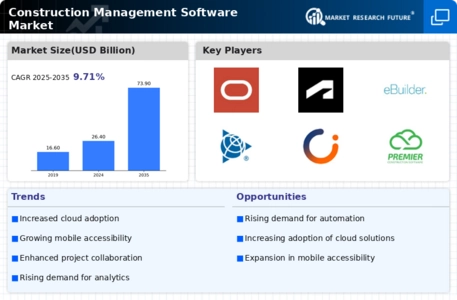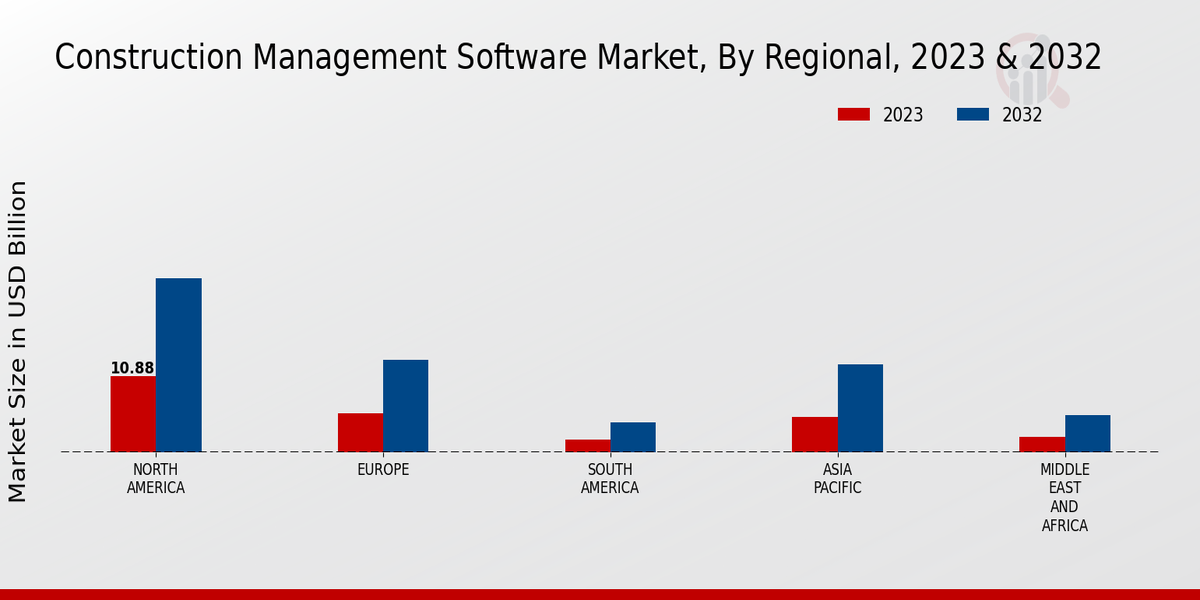Growing Adoption of Mobile Solutions
The growing adoption of mobile solutions is reshaping the Global Construction Management Software Market Industry. As construction teams increasingly operate in the field, the demand for mobile-compatible software solutions has surged. These applications enable real-time communication, data sharing, and project updates, which are crucial for maintaining project timelines and budgets. The convenience of mobile access allows for quicker decision-making and enhances collaboration among team members. This trend is likely to continue, as more companies recognize the benefits of mobile technology in improving operational efficiency and project management.
Increased Demand for Project Efficiency
The Global Construction Management Software Market Industry experiences heightened demand for project efficiency, driven by the need to streamline operations and reduce costs. As construction projects become more complex, stakeholders seek software solutions that enhance collaboration and communication among teams. In 2024, the market is projected to reach 26.4 USD Billion, reflecting a growing recognition of the importance of efficient project management tools. Companies are increasingly adopting software that integrates various functions, such as scheduling, budgeting, and resource allocation, to improve overall productivity and project outcomes.
Regulatory Compliance and Safety Standards
Regulatory compliance and safety standards are increasingly influencing the Global Construction Management Software Market Industry. Governments worldwide are implementing stricter regulations to ensure safety and environmental sustainability in construction projects. Software solutions that assist in compliance management, risk assessment, and safety training are becoming essential tools for construction firms. By leveraging these technologies, companies can mitigate risks associated with non-compliance and enhance their reputation in the market. The emphasis on safety and compliance is expected to drive market growth, as firms prioritize investments in software that supports these critical areas.
Global Infrastructure Development Initiatives
Global infrastructure development initiatives are a significant driver of the Global Construction Management Software Market Industry. Governments and private sectors are investing heavily in infrastructure projects, such as transportation, energy, and housing, to stimulate economic growth. This surge in construction activity necessitates robust management software to handle the complexities of large-scale projects. As the market evolves, it is anticipated that by 2035, the industry will reach 73.9 USD Billion, underscoring the critical role of construction management software in facilitating successful project execution and resource management.
Technological Advancements in Software Solutions
Technological advancements play a pivotal role in shaping the Global Construction Management Software Market Industry. Innovations such as Building Information Modeling (BIM), artificial intelligence, and cloud computing are transforming how construction projects are managed. These technologies enable real-time data access, predictive analytics, and enhanced visualization, which can lead to better decision-making and risk management. As a result, the market is expected to grow significantly, with a projected CAGR of 9.81% from 2025 to 2035. This growth indicates a strong inclination towards adopting cutting-edge technologies that improve efficiency and reduce project delays.

























